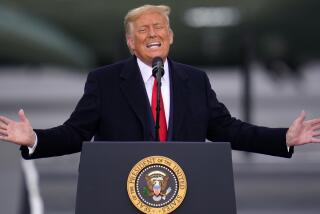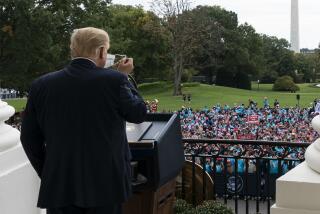Trump’s dangerous message on coronavirus

- Share via
WASHINGTON — In the six weeks since a new coronavirus emerged in China, President Trump has offered one blithely optimistic message: Don’t worry — Dr. Trump has the problem under control.
“We’re doing great,” he said at a rally two weeks ago. “We only have 11 cases, and they’re all getting better. ... It looks like by April, in theory, when it gets a little warmer, it miraculously goes away. I hope that’s true.”
The president was upbeat again on Tuesday, even though the epidemic has spread to at least three dozen countries and more than 80,000 confirmed cases.
“I think that’s a problem that’s going to go away,” he told reporters in India. The virus “is very well under control in our country.”
But the president has his facts wrong — and his message, too.
The Centers for Disease Control and Prevention, which has confirmed 53 American cases, warned that the fast-moving virus is likely to hit the United States hard.
“It’s not so much of a question of if this will happen in this country anymore, but a question of when,” the CDC’s chief immunization officer, Dr. Nancy Messonnier, told reporters. “We are asking the American public … to prepare for the expectation that this is going to be bad.”
She said she told her children: “We as a family ought to be preparing for significant disruption to our lives.”
If Trump treats his scientists the way he treats intelligence officials who bring him bad news, Dr. Messonnier can expect a nasty tweet — or worse — any day now.
Trump returns from India Wednesday to find the stock market — the one he keeps boasting about — unraveling, with the Dow Jones industrial average dropping more than 1,900 points in two days. That’s the biggest two-day slide in history, all due to fears of the coronavirus.
“Stock market starting to look very good to me!” Trump tweeted Tuesday morning, after the first day’s selloff. Investors didn’t buy it.
The epidemic is already hurting the economy, beginning with airlines and companies with supply chains in China. Beijing may not be able to meet its promise to buy $77 billion in U.S. goods this year under an interim trade deal. The pain could get a lot worse if Americans are afraid to travel, eat out, attend public events or even go to work.
All of which means the coronavirus could affect the presidential election, too.
Trump’s main selling point is that he’s presided over an economic boom with low unemployment and growing wages. There’s no sign of a recession, but growth is already slowing — and if it decelerates further, the president’s sales pitch could ring hollow.
And the epidemic could pose a bigger challenge for Trump: It’s a high-visibility test of his competence.
Voters often judge an incumbent president by how he performs in a crisis.
George W. Bush’s popularity took a nosedive after Hurricane Katrina in 2005, when his administration failed spectacularly at providing flood relief to New Orleans. Barack Obama’s popularity took a hit after a BP oil well blew out in the Gulf of Mexico in 2010 — and fell further when his administration bungled the rollout of his healthcare plan in 2013.
Trump’s White House operates in perpetual chaos. Now it faces an external crisis that will require coordinating multiple federal agencies with state and local authorities.
Until 2018, the White House had an office dedicated to planning for international epidemics, but Trump abolished it.
“A single coordinator for the response would be useful,” Ronald A. Klain, who led the Obama administration’s response to an Ebola outbreak in 2014, told me. “If that job were still in place … you’d already have someone in the seat.”
Instead, Trump created a task force headed by Alex Azar, his secretary of Health and Human Services — but it’s basically a committee of officials who have other day jobs.
Azar and White House acting Chief of Staff Mick Mulvaney spent weeks arguing over how much money to ask from Congress for the coronavirus crisis. Azar wanted more; Mulvaney, a relentless budget cutter, wanted less. They finally settled on $2.5 billion, which Azar proposed on Tuesday — long after the request could have been made, Democrats said.
Mulvaney has also proposed a budget that would slash the government’s main epidemic-fighting agencies, including the CDC and the Public Health Service by billions of dollars. That doesn’t seem very sensible right now.
Meanwhile, it’s not clear that the White House has a detailed plan for dealing with a coronavirus epidemic in the United States.
“What is being communicated to public health [and] safety professionals and the public?” Juliette Kayyem, a former Homeland Security official, asked. “What standards for school closings and how will they be enforced? Will major events be canceled and what are the standards for doing so?”
“I haven’t heard planning … for these relatively simple measures,” she wrote.
The consequences of failure could be dire, she warned. “Panic is a result of a public believing there is no plan.”
Trump isn’t to blame for the coronavirus. He won’t be to blame if China’s economic slowdown sparks a global recession.
But a president who claims credit when the stock market goes up cannot blame others when the stock market plummets — although he’s sure to try.
As a businessman who boasted he could run the country better than any politician, Trump will deserve the blame if his administration bungles this crisis. His competence will be on trial.
He appears to be whistling past the quarantine station hoping the epidemic doesn’t spread. So far, he’s been lucky — but luck is not a strategy.
More to Read
Get the L.A. Times Politics newsletter
Deeply reported insights into legislation, politics and policy from Sacramento, Washington and beyond. In your inbox twice per week.
You may occasionally receive promotional content from the Los Angeles Times.











